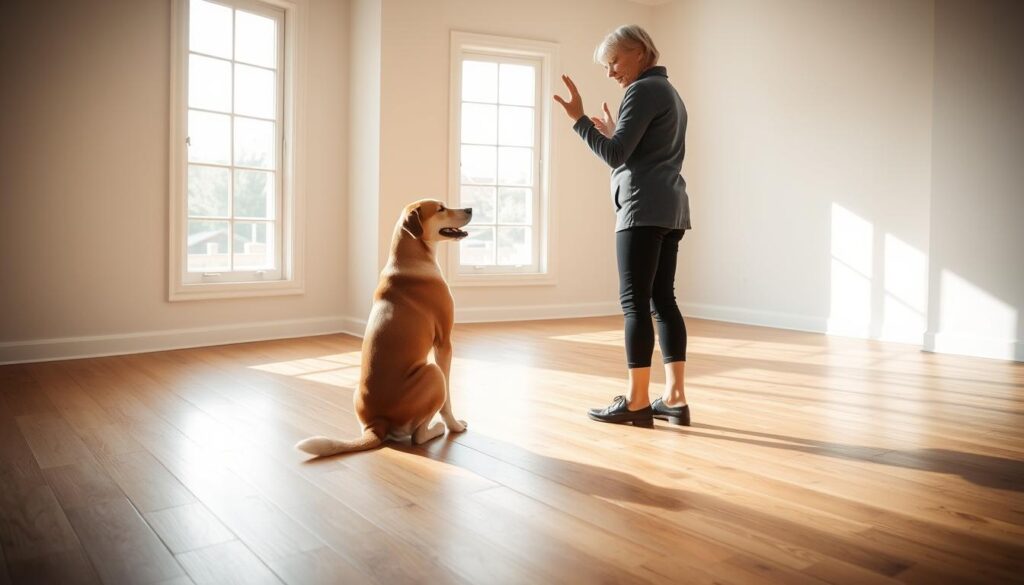Are you ready to open your heart and home to a rescue dog? Welcoming a new furry friend into your family can be a rewarding experience, but it requires thoughtful preparation to ensure a smooth transition for both your family and your new pet.
Rescue dogs often come with unique challenges due to their past experiences. By understanding their needs and taking steps to create a welcoming environment, you can help your new dog adjust to their new life with minimal stress.
This comprehensive guide will walk you through the essential steps to get your home ready for a rescue dog, setting realistic expectations for their adjustment period and establishing a strong foundation for a successful adoption.
Key Takeaways
- Understand the needs of a rescue dog and the challenges they may face.
- Learn how to create a safe and welcoming environment for your new pet.
- Discover the 3-3-3 rule for a rescue dog’s adjustment period.
- Follow the 7 must-do steps to prepare your home for a rescue dog.
- Establish a strong foundation for a successful adoption and a happy family.
Understanding What Rescue Dogs Need
The process of adjusting to a new home can be challenging for rescue dogs, making it essential to understand their needs. Rescue dogs come from various backgrounds, and their past experiences can significantly influence their behavior and adjustment to a new environment.
The Unique Challenges of Rescue Dogs
The Unique Challenges of Rescue Dogs
Rescue dogs often face unique challenges as they adapt to their new surroundings. These challenges can stem from past traumas, lack of socialization, or unfamiliarity with household rules and routines. Understanding these challenges is crucial for providing the right support and care.
A key aspect of supporting your rescue dog is recognizing the signs of stress and anxiety, such as hiding, not eating, or being overly quiet. By acknowledging these signs, you can take appropriate measures to comfort and reassure your dog.
The 3-3-3 Rule of Adjustment
A helpful framework for understanding the adjustment process of rescue dogs is the 3-3-3 rule. This rule outlines the typical phases a rescue dog goes through in the first 3 days, 3 weeks, and 3 months in a new home.
| Timeframe | Adjustment Phase | Characteristics |
|---|---|---|
| First 3 Days | Overwhelmed | Scared, hiding, not eating or drinking |
| First 3 Weeks | Exploration and Learning | Starts to understand household routines, tests boundaries |
| First 3 Months | Settling In | Feels more comfortable, builds trust, settles into family dynamics |
By understanding the 3-3-3 rule, you can better support your rescue dog through each phase of their adjustment, making the transition smoother for both you and your dog.
Step 1: Dog-Proof Your Home
The first step in welcoming a rescue dog into your family is to transform your home into a safe haven. This involves a thorough assessment and modification of your living space to prevent potential hazards.
Identifying and Removing Hazards
Begin by walking through your home and yard to identify potential dangers. Look for items that could be harmful if ingested or that could cause injury. This includes toxic substances, electrical cords, and sharp objects. Securing these hazards is crucial to creating a safe environment for your dog.
As you inspect your home, make a list of the hazards you’ve identified and prioritize them based on the level of risk they pose. This will help you tackle the most critical issues first.
Securing Dangerous Items and Areas
Once you’ve identified potential hazards, it’s time to secure them. Store cleaning supplies, medications, and toxic substances in locked cabinets or on high shelves where your dog cannot access them. Use trash cans with locking lids to prevent your dog from getting into harmful food waste or packaging.
Additionally, secure loose electrical cords with cord covers or cord management solutions to prevent chewing. Pay special attention to areas like swimming pools, workshops with tools, laundry rooms with detergents, and bathrooms where medications are stored. These areas can be particularly hazardous for dogs.
Step 2: Create a Safe Space
Once you’ve dog-proofed your home, the next step is to create a safe space for your rescue dog. This area will serve as a sanctuary where your dog can retreat when feeling overwhelmed.
Setting Up a Crate or Quiet Area
Deciding whether to use a crate or designate a quiet area depends on your dog’s needs and your personal preferences. A crate can provide a sense of security and help with housetraining. If you choose not to use a crate, identify a quiet area where your dog can relax without being disturbed.
If you have chosen to not use a crate, now is the time to let your dog off the leash and let them investigate the area. By releasing them from the leash, you are clearly reinforcing that this area belongs to them!
Making the Space Comfortable and Inviting
To make the designated space comfortable and inviting, start by selecting appropriate bedding that is both comfortable and durable. Incorporating familiar scents, such as a blanket from the shelter, can create continuity and comfort for your rescue dog.
Strategically place toys, water, and comfort items within the space to make it appealing. Consider the ambiance by adjusting lighting, noise levels, and temperature to help your dog feel secure and relaxed. A comfortable bed and a familiar scent can go a long way in making your dog feel at comfort.
Step 3: Gather Essential Supplies
Once you’ve dog-proofed your home and created a safe space, it’s time to gather the essential supplies your rescue dog will need. This is often the most enjoyable part of the preparation process, as it allows you to pick out fun and necessary items for your new pet.
Food, Bowls, and Feeding Stations
Selecting the right food and feeding equipment is crucial. Choose a high-quality dog food that suits your dog’s age, breed, and dietary needs. Stainless steel or ceramic bowls are recommended for their durability and ease of cleaning. Consider a feeding station to keep the area organized and comfortable for your dog.
Collars, Leashes, and ID Tags
A collar, leash, and ID tag are essential for walking and identifying your dog. Ensure the collar is comfortable and adjustable, and the leash is sturdy. Personalize the ID tag with your dog’s name and your contact information.
Toys, Beds, and Comfort Items
Toys are vital for providing comfort, enrichment, and mental stimulation. Choose toys based on your dog’s size, chewing style, and play preferences. Different types of toys serve various purposes: comfort toys for reassurance, interactive toys for engagement, chew toys for dental health, and puzzle toys for mental stimulation. A comfortable bed is also essential, considering factors like washability and durability. Additionally, comfort items such as snuggle toys with heartbeat simulators or scent holders can help ease anxiety.

Step 4: Establish Boundaries and Rules
To ensure a smooth transition for your rescue dog, establishing boundaries and a consistent family vocabulary is key. This step is crucial in creating a structured environment that helps your dog understand what is expected of them.
Deciding on House Rules Before Arrival
Before your rescue dog comes home, it’s essential to decide on house rules that everyone in the family will follow. This includes rules about where the dog is allowed to go in the house, whether they are allowed on furniture, and any areas that are off-limits. Consistency is vital to avoid confusing your dog.
Key House Rules to Consider:
- Allowed areas in the house
- Furniture access
- Rooms or areas off-limits
- Mealtime rules
Creating a Consistent Family Vocabulary for Commands
Take time to create a vocabulary list that everyone will use when giving your dog directions. This helps prevent confusion and aids your dog in learning commands more quickly. Basic commands such as “sit,” “stay,” “come,” and “leave it” should be established immediately.
Consistency in tone, hand signals, and verbal cues is crucial. Avoid using synonyms or contradictory commands that might impede your dog’s training progress.
| Command | Verbal Cue | Hand Signal |
|---|---|---|
| Sit | “Sit” | Raise hand, palm facing upwards |
| Stay | “Stay” | Hold out hand, palm facing outwards |
| Come | “Come” | Open arms or point towards yourself |

Step 5: Prepare Your Yard and Walking Routes
Before bringing a rescue dog home, it’s essential to ensure your yard and neighborhood walking routes are safe and welcoming. This preparation is crucial for the dog’s safety and to help them adjust to their new environment.
Yard Safety Checks
Checking your yard’s security is vital. Ensure that your fence is sturdy and high enough to prevent escape attempts. Remove any hazardous materials or objects that could harm your dog. Also, check for any gaps or weak spots in the fence and repair them before bringing your dog home. A safe yard provides a secure area for your dog to relax and exercise.
Secure your yard to prevent any potential risks. This includes checking the fence and removing hazardous materials.
Planning Safe Walking Routes
Once you arrive home, taking your dog for a long walk around the neighborhood is recommended. This initial walk helps drain surplus energy and acclimate your dog to the new environment. When planning your walking routes, start with quiet and low-stimulus areas to avoid overwhelming your dog. Gradually increase exposure to different environments, people, and other dogs based on your dog’s confidence level.
Recognizing signs of stress or overstimulation during walks is crucial. Watch for body language cues such as tail tucking or yawning, and respond by changing your route or ending the walk if necessary. Proper leash handling, rewards, and allowing your dog time to sniff and explore can create positive associations with walking.
Step 6: Create a Routine and Schedule
A consistent daily schedule is vital for helping your rescue dog feel secure and adjust to the new environment. Establishing a routine provides a sense of stability and helps in reducing anxiety.
Planning Feeding Times
Deciding on a feeding schedule is crucial. It not only helps in maintaining your dog’s health but also in housebreaking. Feed your dog at the same times every day, and consider dividing the daily ration into 2-3 meals for better digestion and satisfaction.
For example, you can feed your dog at 7 am, 12 pm, and 6 pm. Consistency in feeding times helps your dog understand what to expect, reducing stress and making mealtime more enjoyable.
Establishing Exercise and Potty Schedules
Regular exercise and potty breaks are essential for your dog’s physical and mental well-being. Take your dog out for walks and potty breaks at the same times daily, such as first thing in the morning, after meals, and before bedtime.
A sample schedule could look like this:
| Time | Activity |
|---|---|
| 7:00 am | Morning Walk/Potty Break |
| 12:00 pm | Lunch and Potty Break |
| 6:00 pm | Evening Walk/Potty Break |
| 9:00 pm | Last Potty Break Before Bed |
Setting Up Training and Bonding Time
Incorporating training and bonding activities into your daily routine is vital. Spend time on short, positive training sessions, focusing on basic commands like “sit,” “wait,” and “down.” Reward your dog after a walk, some training, and a meal, as this is the best time to shower them with love and affection, enhancing the bonding experience.
By balancing structured training with relaxed bonding time, you create a well-rounded relationship with your dog. Recognize your dog’s learning style and energy levels to tailor appropriate training and bonding opportunities.
Step 7: Prepare Your Family and Mindset
Preparing your family for a new rescue dog is just as important as preparing your home. A well-prepared family ensures a smoother transition for both the dog and the household members.
Setting Realistic Expectations
It’s essential to set realistic expectations when adopting a rescue dog. Understand that the dog may need time to adjust to its new environment, and it’s not always immediately affectionate or obedient. Never leave a child alone with your new dog, even for a second. The relationship between children and dogs portrayed on TV is often unrealistic and can lead to unsafe interactions.
Teaching Children How to Interact with the New Dog
Teaching children how to interact with the new dog is crucial for the safety and well-being of both the children and the dog. Encourage gentle touch and calm behavior around the dog. Supervision is key to preventing any potential harm. Children should be taught to respect the dog’s space and recognize stress signals. By doing so, you can create a positive and safe environment for both your children and your new rescue dog to thrive.
The First Days: What to Expect When You Bring Your Rescue Dog Home
As you welcome your rescue dog into your home, it’s essential to understand what to expect during the first few days. During this period, your dog will be adjusting to a new environment, people, and rules. It’s a critical time that requires patience, understanding, and a well-planned approach.
The Arrival Day Plan
On the day you bring your rescue dog home, have a plan in place to ensure a smooth transition. This includes having all necessary supplies ready, such as food, water, bowls, and a comfortable place for your dog to rest. Keep the environment calm and quiet, minimizing loud noises that could stress your dog further.
Key steps for the arrival day:
- Minimize interactions with multiple family members at once.
- Introduce your dog to one room at a time to avoid overwhelming them.
- Provide a safe space or crate where your dog can retreat if feeling overwhelmed.
Signs of Stress and How to Help
It’s normal for rescue dogs to exhibit signs of stress during the initial days. These signs can include panting, pacing, hiding, or refusing food. Recognizing these signs is crucial to providing the right support.
| Signs of Stress | How to Help |
|---|---|
| Panting, Pacing | Provide a calm environment, reduce noise levels. |
| Hiding | Respect their need for space, ensure access to a safe area. |
| Refusing Food | Offer familiar food, maintain a consistent feeding schedule. |

By understanding and responding appropriately to these signs, you can help your dog adjust more comfortably to their new home.
Troubleshooting Common Challenges When You Prepare Home for Rescue Dog
Preparing your home for a rescue dog involves more than just dog-proofing; it also requires understanding how to overcome the challenges that come with integrating a new pet into your family. As you welcome a rescue dog into your home, you may encounter various behavioral issues that require patience, understanding, and sometimes professional help.
Handling Initial Behavioral Issues
Initial behavioral issues in rescue dogs can range from anxiety and fear-based behaviors to difficulties with house training. It’s essential to approach these issues with empathy and a clear understanding of how to address them. Positive reinforcement training is a highly effective method for helping your dog adjust to their new environment.
When to Seek Professional Help
If you encounter behavior issues you’re unfamiliar with, it’s advisable to ask your veterinarian for a trainer recommendation. A professional dog trainer who uses positive reinforcement techniques can provide you with the tools and strategies needed to help your dog overcome behavioral obstacles. Recognizing when to seek professional help is crucial, especially if you notice signs of aggression, severe anxiety, or self-harm.
Conclusion
With the seven essential steps outlined in this article, you’re now ready to create a welcoming home for your rescue dog. Preparing your home is just the beginning; it’s the love, patience, and consistency you provide that will help your dog adjust to their new home. By sticking to the schedule you’ve created, ensuring your dog has the food, potty time, and attention they need, you’ll be well on your way to a happy and healthy relationship. The journey of adoption is rewarding, and with time, your rescue dog will blossom into a confident companion, filling your life with love and companionship.
Remember, the adjustment period is temporary, and the rewards of providing a loving forever home are immeasurable. By preparing your home for a rescue dog thoughtfully, you’re not just giving them a home; you’re giving them a second chance at a happy life.



4 Comments